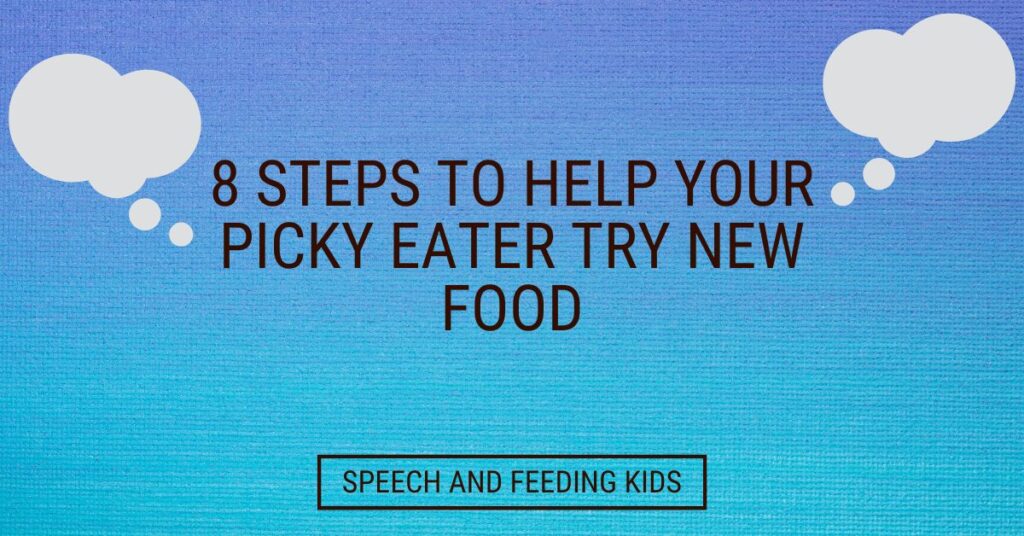Let’s explore food with a picky eater…
The language we use in feeding therapy matters. “Let’s explore food” is very different than “It’s time to eat your food”. The act of eating a bite of food is binary, you either eat the bite, or you don’t. This can be scary for many children, especially picky eaters and children who lack the adequate oral sensory-motor skill necessary to eat. A great way to decrease some of their fear and tension around eating new food, is to teach your picky eater to explore food.
This article is not meant to substitute professional help. Many children are hesitant to try new foods for a variety of reasons. It is important to look at why your child seems to be a picky eater. Some children present as “picky” because they haven’t had many opportunities to expand on what the eat. Other children are found to be “picky eaters” for a wide variety of sensory-motor, medical, social-emotional, or physical reasons. If you have ANY concerns with your child’s ability to safely manage or eat food, please contact your doctor or a professional who specializes in feeding therapy.
Most children with adequate oral sensory-motor skills should eventually be able to move through this list with age appropriate foods. IF your child is having a really hard time moving past a certain step, or engaging at all, this might be an indicator that they may need a little extra support from a professional feeding therapist.
Here is an approach for how to help your picky eater explore food. The overall goal is to help your child learn to explore food and expand the variety foods they will eat. ALL foods that you present to your child should be foods that you are 100% sure the child is able to safely swallow (puree) or chew (solids).
8 Steps to Exploring New Foods
1. Look at it
2. Touch it
3. Smell it
4. Kiss it
5. Lick it
6. Put it on your teeth
7. Bite and spit out
8. Bite and eat
Think of this a list of ways to explore going from least invasive (Step 1: looking at it) to the full experience of chewing and swallowing (Step 8: bite and eat).
For each of these steps watch the child’s body language and facial expressions. If they are talking (“This smells funny”, “It’s too spicy”, “It’s gross”) listen to what they are saying as an absolute truth of what they are experiencing. Having the right language to describe food is another part of therapy that we can also work on as the child begins to progress.
Each one of these steps is a different experience. They are all different levels. For some children it is a world of difference moving from kissing food, to licking food, to putting food on their teeth. Even though it’s all a part of our mouth, putting the same food on each one of these body parts will be a different sensory experience at first.
The most important thing you need to do as the adult is DO EXACTLY WHAT YOU SAY. If you say “let’s kiss the food” do just that. If you say, “Let’s kiss the food”, they open their mouth, and you sneak the food in their mouth, you’ve broken their trust. Make it abundantly clear through your words and your actions that you will do EXACTLY what you say. This is how you build trust which is essential when exploring foods.
This post may include affiliate links. As an Amazon Associate I earn from qualifying purchases. Read the full disclosure here.
How to use each step to explore new food
Look at it
Present the new food in front of the child on their tray/table and see how they respond. Are the curious? Do they notice it? Do they immediately become upset?
This is a crucial step you can always resort back to. At the very least can the child look at the food? If they won’t do anything else you can look at the food and talk about it, then praise them for, “exploring the food”. This may seem silly at first for the adult. Look at this step as a gateway into having the child buy into the idea of exploring food. Praise for this step might look like this, “Hey you did great exploring, we were able to look at the food for two minutes and you told me what colors you saw”.
If they can’t stand the sight of the food, move it across the room and look at it. Then see if they can get closer and closer until it’s on their plate in front of them. If just being around certain foods is really upsetting, we need to ask why, and consider if there are some underlying sensory concerns that are causing the child to demonstrate these behaviors.
Touch it
Ask the child to touch the food. If they refuse, see how you can make a game out of touching it for a split second. If this is still hard, see if they will touch it with a utensil.
Smell it
Tell the child, “Let’s smell it!”. Show them how you smell it, then present it 5-10 inches from their face so they can smell it. See if next time they will hold it a little closer to smell it.
Kiss it
“Let’s give it a kiss!” This is a big step. Some kids find this step really funny, OR this where the child stops. This is usually the step where the child tastes the food on their lips and decides it’s safe to eat, OR it’s too much for them to handle the food coming to their mouth and they shut down. I find when they kiss the food, they get a small taste of the food, and they are more likely want to try more.
Lick it
“Let’s give it a lick!” Notice, do they stick their tongue all of the way out, or are they still really not sure and they just barely stick their tongue out of their mouth. This is a big step as the food has now willingly entered past the level of their lips, into their mouth. Even if it’s a micro-drop of food that ends up on their tongue, make a big deal about how they allowed the food into their mouth.
Put it on your teeth
This step you’re going to tap the food on their teeth. They DO NOT have to bite. All they are doing here is experiencing what the food feels like on their teeth for a second.
Bite and spit out
This step may seem counter intuitive to a lot of parents; however, I find that giving the child the power to make the decision to spit it out is a much more attractive option than “just eat it”. If the child starts to consistently spit the food out after 1 bite, see if you can playfully challenge them to do 1 bite a 1 chew, or 1 bite and hold it in their mouth for 2-3 seconds then spit it out calmly onto their plate.
Bite and eat
This is the final step. Make a big deal out the first time they make their way through the progression. Explain to them how they worked through it, were brave, and did something new!
Helpful strategy within the final step: Give the child the option to take a sip of water, or their favorite drink after they swallow their food. You can explain to them if it is the flavor of the food they are nervous about, they can immediately wash the flavor out with their drink once they have safely swallowed. Once this starts to become easy, see if they can take two bites then a drink, then three bites and a drink, then a bite without any drink/chaser.
Final thoughts on exploring food
Exploring food is not about the child clearing their plate. It’s about the relationship the child is developing around exploring food. We are building a skill set in the child that will facilitate an internal drive to want to try and explore new foods. It’s a skill set and a mindset that can move your child from a picky eater, to a child who loves exploring food.
If the child will kiss it, but won’t lick the food, see if they can kiss the food 2 times, then 3 times. You can do this with any level. Keep upping the demand of the level they are comfortable with until they slide into the next step. The best advice I can give is; come to the table with unlimited patience, make it fun, and end on a good note. Leave them feeling happy so they will be more willing to come back the next time. Note what step your child is on with a specific food at the start, and get excited over any progress big or small. Good luck!
For more speech and language tips, follow Speech and Feeding Kids on YouTube.
About the Author
DRAKE HASTINGS M.S., CCC-SLP
Drake Hastings is a speech-language pathologist who specializes in speech, oral motor, and feeding therapy for kids. Drake has a passion for working with children and families while helping children achieve goals using a fun and motivating approach to learning.
Drake’s main areas of focus within the practice are feeding therapy, and speech (sound production) therapy. Drake has experience working with children who are diagnosed with Autism Spectrum Disorder, Apraxia of Speech, Dysarthria, Down Syndrome, and rare genetic disorders. Drake has experience working and collaborating with a wide variety of families and therapeutic team members while treating children of all ages.


